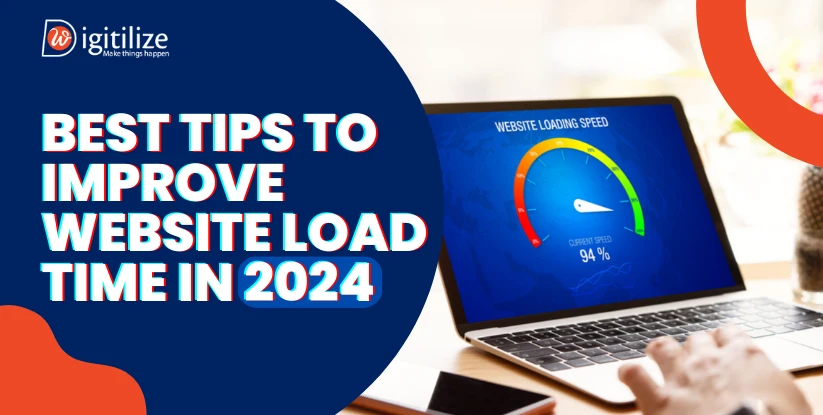Best Tips to Improve Website Load Time in 2024

Your sluggish website slows down the success of your entire business. Every stage of your sales funnel is impacts: a slow-loading website negatively impacts conversions. The user experience, Google rankings, and other KPIs. The catch is that you have to continuously check and optimise the speed of your website. That is why we have discussed the best tips to improve website load time in 2024.
However, if your company depends on an online presence, you cannot afford to ignore performance optimisation. The good news is that most performance optimisation concepts hold, even though actual implementations may vary. Regardless of the kind of website or platform you use, the approaches are essentially the same. Images, front-end and back-end code, caching, hosting, third-party modules, and other issues are covers. Ten suggestions for optimising page performance are provided in this article, along with solutions for some of the most typical problems.
What is speed optimisation for websites?
Website speed optimisation is the process of making your pages load more quickly. Its goal is to load your e-commerce store as quickly as possible so that potential customers can close their browser tab and get unsatisfied with their online experience. Another name for this method is website performance optimisation.There are two key metrics used to evaluate speed: The speed at which content loads from a URL is measured as page speed.
The speed of a website may be apply to determine how well it functions overall. Services like Google PageSpeed analytics calculate a score by combining the various load times on your website.
Google recommends a page load speed of two seconds for e-commerce websites. On the whole, nevertheless, quickness is helpful. For each and every that your website takes to load, your average conversion rate as an e-commerce business drops by 0.3%.
Best tips to improve website load time in 2024
-
Make your photos as good as possible.

Visuals and images are a terrific way to present information to your visitors, but they take up more space and are heavier than plain text, which might slow down the loading of your website if they are not properly optimised. You can make sure that the photographs you put on your page don’t slow down your website with a few effective methods. First, by making sure your photographs are sized correctly, you may optimise them. This is one of the best tips to improve website load time in 2024. The browser still downloads and loads the original image in its original size even if you use CSS to scale it from 500×500 pixels to 250×250 pixels. This means that the browser is loading an image that is four times larger than it needs to be.
-
Cut back on the number of HTTP queries you make.
Use your CSS instead of background pictures, observe how social integration impacts load speeds, and, if at all feasible, think about eliminating any unnecessary JavaScript to do this. A browser prioritises loading non-asynchronous JavaScript and won’t attempt to load other content while it’s doing so. This has a significant impact on how quickly pages load.
-
Don’t use any JavaScript above the fold.
-
Decrease the speed at which a website loads using location
-
Make Use of a Content Delivery Network
-
Put AMP to use on your landing page.
-
Select a Better Web Hosting Company

Is the hosting on your server adequate? To store and administer the website’s code, media files, databases, content management system, web server, and other components, it should be both current and robust. It should also be able to handle seasonal upswings in traffic as well as your typical traffic volume. Find out if the hosting you’re using is the greatest fit for the needs of your specific website if you need clarification on any of these variables.
Even though the server is still supporting several clients, the structure has made it quicker. This is one of the best tips to improve website load time in 2024. The fact is, every website is separated from the others on its virtual server. Other websites cannot use its resources on the same VPS, and it has unique setups. It’s ideal for medium-sized companies, but a website with a lot of traffic would need a more powerful system.
-
Save Web Pages in Cache
-
Turn on Caching for Browsers
-
Recognise asynchronous loading.
-
Reduce the number of plugins.
To know more follow us on LinkedIn.
FAQ
Frequently Asked Questions
If your ecommerce platform isn't designed for speed, your website may load slowly, your site architecture isn't optimised, or your website utilises a lot of huge assets, including photos.
An online shopper's chance of making a purchase from your store is directly impacted by the speed of your website. Research indicates that websites with a one-second load time have a 2.5 times greater conversion rate than those with a five-second load time.
Prioritizing critical CSS ensures that essential styles are loaded first, expediting the rendering of key page elements for a better user experience.
Fewer redirects minimize additional HTTP requests and latency, contributing to quicker overall page loading times.
Code optimization involves streamlining and cleaning up code, resulting in improved overall page performance and faster loading times.
Minifying CSS, JavaScript, and HTML is crucial for page performance because it reduces file sizes by eliminating unnecessary characters and whitespace. Smaller files load faster, optimizing data transfer and decreasing the time it takes for browsers to render and display web pages, thereby enhancing the overall user experience.

